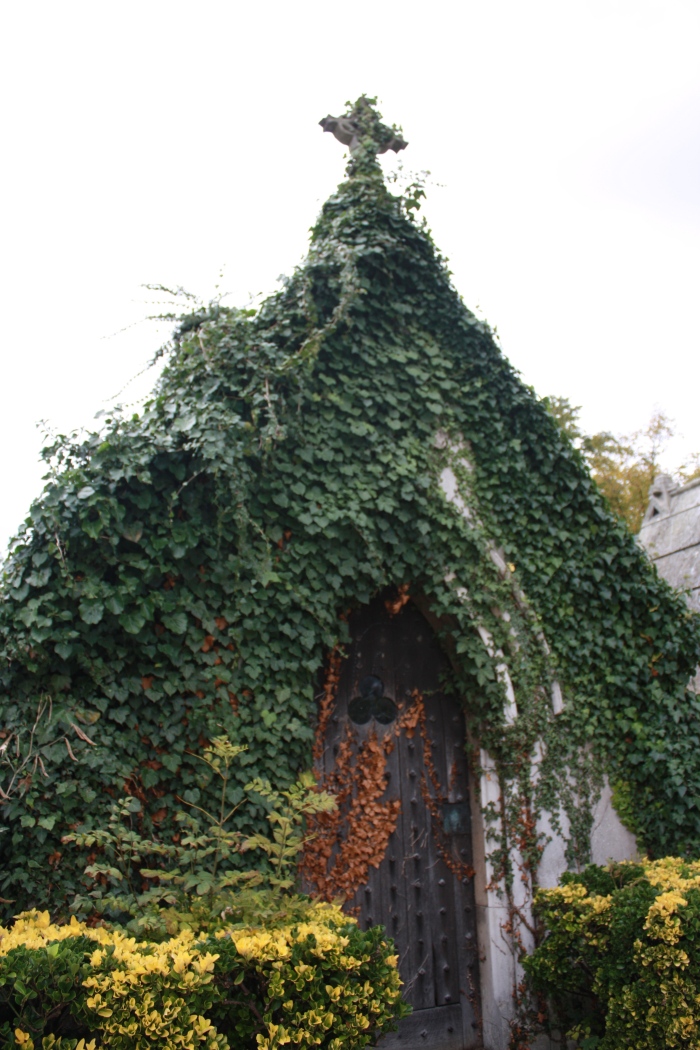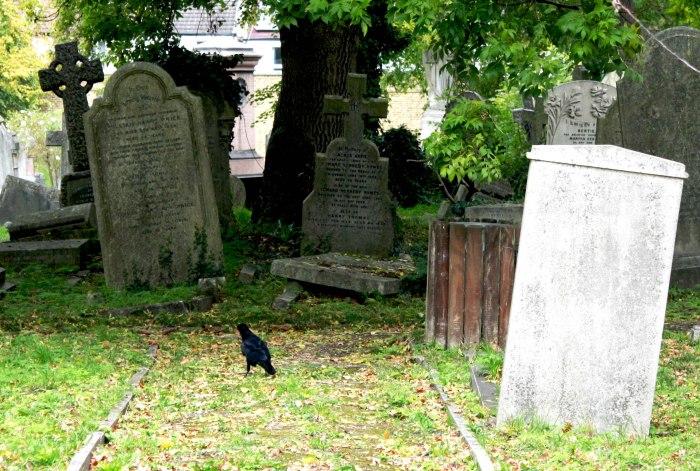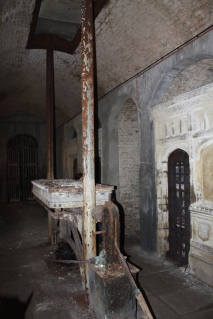
As the lights change a silver Audi guns its engine, switching lanes in order to speed past a 432 bus, determined to be first out of the traps, past St Luke’s, under the railway bridge and away along Norwood High Street. On the other side of the church – a rocky mid-river island between traffic – more cars trundle north down Knights Hill, already busy on this bright autumn morning.
Norwood is yawning but awake: shopping, grabbing coffee, heading for breakfast, haircuts, workouts, dates. Watching Saturday unfold beyond the cemetery gates, it’s a little difficult to picture a time when almost none of this was there.
In 1837 London was growing rapidly and expanding at the edges. The city had an urgent need for space and not just for its living. Traditional city centre churchyards and dissenters’ burial grounds were full to bursting – the metropolitan dead also needed somewhere to go.
London’s first large inter-denominational commercial cemetery had opened four years earlier at Kensal Green; West Norwood (at that time still Lower Norwood) was to be next. In the year Queen Victoria acceded to the throne and Dickens’ Oliver Twist was first published in serial form, the South Metropolitan Cemetery opened for business – designed by the architect Sir William Tite, himself a director of the cemetery company (and now buried in it).
The scene visible through the entrance gates back then would have been rather different. Whilst not quite surrounded by rolling hills and meadows the view over the cemetery would have looked more pastoral than urban. An anonymous artist’s impression, dated from around the time of the site’s opening and reprinted in John Coulter’s excellent Norwood Past, shows a view looking down and over the burial ground from the vicinity of today’s Landsdowne Hill. St Luke’s is present on the right (consecrated in 1825) and a scattering of buildings line Norwood High Street, while out of shot a predecessor of today’s Horns Tavern would have faced the church, but largely, the 42 walled acres of the cemetery sit within what appears to be a rural landscape. Open fields and clumps of trees surround the grounds, with the canopy of Norwood ridge looming in the background.

Pretty soon though houses and shops would begin to spring up all around, lining the major routes in ribbon developments and rapidly filling the gaps in between along new side streets as well: for the next few years the brickfields of Lambeth would be busy.
I imagine mid 19th century West Norwood looking something a little like the future Lyon Estates in Back to the Future, at the moment when Marty Mcfly goes back in time to 1955 to find tarmacked ground and lion-topped pedestals in the middle of a field, the houses awaiting construction; only here multiplied a hundredfold.
Odd though it might seem today, the cemetery was part of the draw for Victorian developers. As John Coulter puts it: “The new prominence the cemetery gave to West Norwood produced a spurt of development, especially in the field of middle-class housing. It seems strange to us, the idea of building a smart suburb around a cemetery. We might find it depressing to gaze down for years from our expensive gardens in Royal Crescent or Central Hill, upon our final resting place. To the Victorians the experience was spritual, uplifting and above all serious…”
Back in present day West Norwood cemetery I’m one of a small group visiting for a tour of its catacombs. After a short wait, a man comes bounding over, gathers us together, bids everyone welcome, finds out where we’ve all come from and then beckons us off amongst the tombstones.
Colin Fenn is one of the Friends of West Norwood Cemetery – though technically everyone on this tour is, as for insurance purposes you have to be a member in order to gain entry to the catacombs. Colin though is deeply involved and he clearly knows his stuff. As part of a rapid barrage of important dates, facts and figures we learn that while West Norwood was only the second large commercial cemetery to be built in London, it was the world’s first in the Gothic style, establishing the dominant look and feel for Highgate and many others that would follow: along with the archetypal fog bound, wooded grave side scene, through which a coach and four would race in so many Hammer Film productions.



Before we get to the catacombs themselves – near the top of the hill beneath the former Anglican (Episcopal) chapel – we are given the stories behind some of the graves and monuments and the people they contain. We hear about some of the most notable occupants, including sugar and art collecting’s Sir Henry Tate – also builder and benefactor of some of the Lambeth libraries, which the borough is now busily shrinking or closing – and Mrs Isabella Mary Beeton of cook book fame.
Next we visit Lucy Gallop (1847-1883) portrayed in a tall statue on a granite plinth featuring an inset circular photograph of Lucy transferred to porcelain – an early example of this practise. Nearby Colin points out banker James William Gilbart FRS (1794-1863) memorialised by a Gothic belfry with medallions on the gables – one carved with a squirrel holding an acorn to symbolise savings. We also hear about a man who was, as our guide puts it, ‘indirectly responsible for putting more people under the ground than nearly anyone else’ – Hiram Maxim (1840-1916) inventor of the machine gun, amongst other less destructive things.
Also resident here is Welshman John Hughes, who built and ran a steelworks in the Ukraine from 1869 and in the process founded the city that became Donetsk – originally Yuzovka (a Russianization of Hughes). In 2013 the Mayor of Donetsk and the Ukrainian Ambassador to Britain visited as part of a delegation paying tribute to their city’s originator.
Mostly though, as a civil engineer himself, Colin is keen to point out the graves of engineers, of which West Norwood seems to hold many. A lot of these individuals have a connection with the London underground, including James Henry Greathead (1844-1896) inventor of the Greathead tunnelling shield and engineer for the world’s first deep level underground electric railway – the City & South London Railway – and Charles Pearson (1793-1862) Solicitor to the Corporation of the City of London, MP for Lambeth, who published a pamphlet in 1845 promoting the idea of an underground railway running down the Fleet valley, before twenty years later persuading the Corporation of London to fund the building of the Metropolitan Line. Sadly he died before it was finished.
As Colin’s breathless narrative continues to unfold, he has us hopping from monument to monument, ducking past overhanging branches and zigzagging between graves. The energy and enthusiasm becomes increasingly infectious and despite the fact we’re wandering about in a graveyard, the atmosphere buzzes with a vibrant, almost celebratory feeling.
Colin, it quickly becomes clear, is one of those great British enthusiasts whose tireless voluntarily work, preserves and rescues places that might otherwise be lost. As he springs about, arms flapping, stories flowing, I can’t help but wonder if rather than King Arthur reawakening from beneath a hill to save Albion at time of desperate need, it will be people like Colin Fenn – those passionate friends of cemeteries, parks, libraries, you name it – who will go into battle to save what’s left of Old (and in some cases Quite Recent) England.
These are the vital local heroes who fight back against the pen-wielding, money-blinded apparatchiks of local and national government. Bureaucrats hell bent on assisting the demolition and destruction of anything that stands in the way of ‘progress’ or the property developer’s eternally gaping maw.
As we edge further uphill, ever closer to the catacombs, we hear about Lambeth council’s destructive cemetery based activities between the 1960s and 80s (see point 5. here, or here) when dozens of graves were dug up and moved, some monuments bulldozed and head stones knocked down and broken apart. There’s also time for Colin to throw in an unrelated and almost certainly apocryphal story involving the Effra, (a stretch of which runs beneath the cemetery, although is nowadays contained within the sewer system) flooding and sending a coffin bobbing along through Lambeth to Herne Hill to the dismay of the locals.

Finally the moment we are all here for, the descent to the catacombs. After a push through some atmospheric foliage, we arrive. Rather than the grand Gothic Chapel that once stood here – apparently modelled on Kings College Cambridge – we are faced with the prosaic walls of the memorial rose garden that replaced it when the original building was pulled down in 1960, having been damaged by a V1 ‘Doodlebug’ bomb during World War II and subsequently left to fall into disrepair (Britain’s local authorities weren’t the greatest fans of Gothic Revival Architecture during the white heat of the mid 20th century).
Pausing for a moment before we enter, I imagine the bulky ghost of the building, set proudly above the steps we are about to go down – the great shadowy weight of flying buttresses, tall arched windows and cloud reaching towers are now so much rubble and dust. But beneath this vanquished chapel, the catacombs remain.
Here as the rather unassuming plain wooded door opens – without a creak – someone can’t resist saying: ‘You rang?’. Once inside, Colin begins to speak once more – his voice now a little hushed. He shares some more history, mostly concerning the structure of the building and its contents, but we also hear about a huge stash of cocaine, with a street value of several thousands that was recently retrieved from its hiding place down here in one of the vaults.
The most striking object in the vaulted central chamber is the large catafalque (hydraulic coffin lift) fitted in 1839 by Bramah & Robinson, which squats impressively in the middle. Disconcertingly, this helps make the space look as much like a recently abandoned workshop or surgery from one of those photos of derelict Detroit as a place of the dead – with the catafalque playing the part of dentist’s chair or car mechanic’s trolley-jack.
One either side narrower aisles lead off the central gallery, each with bays and vaults containing stacked coffins, many behind rusty Gothic iron gates and grilles, some fronted with stone panels and armorial crests.


We take our time pacing the corridors, the murmur of quiet questions and the staccato clicks and snaps of cameras the only sounds within the cottony, enfolding quiet. Coffins aside, the place seems surprisingly bare, there are no great sheets of dusty cobwebs, or scuttling noises from mice, or rats. Colin explains that this is because there is nothing down here for creatures like these to eat. Not flies, not maggots, cockroaches or any other insect life. So spiders or rodents don’t hang around. Though there may be some rare forms of mould.
Back outside, back on the surface, in the October sun, crows hop about on the grass, robins, tits and other garden birds flap between branches, a tabby cat slinks across the path and a pair of squirrels scramble up an oak. Along with Oak and Ash and Yew there are a great variety of trees in West Norwood including some impressively huge pines, Cedar of Lebanon and Monkey Puzzle, while shrubs like bramble, ivy, rose and hawthorn abound. Amusingly, according to Colin, although there are no bat colonies in the cemetery itself, they do commute, gathering on spring and summer nights to feast on moths and other insects, before returning to roosts in Dulwich Woods, or Brockwell Park. There are plenty of foxes who do live here though, but none are showing themselves right now.
Heading out on the way home, after the dead stillness of the catacombs, the rest of the cemetery feels very much alive, but as I pass John Hughes’ memorial once more, I can’t help feeling that this lively atmosphere wouldn’t seem quite as pleasant after dark.


Links & References
Friend of West Norwood Cemetery
Subterranea Britannica: West Norwood Cemetery catacombs
Parliamentary Memorandum by The Friends of West Norwood Cemetery
ITV News report on WN Catacombs
Norwood Cemetery An Introductory Guide, Friends of West Norwood Cemetery, 2007,
by Don Bianco, Jill Dudman, Bob Flanagan, Paul Graham, John White & George Young (available from the FOWNC)
West Norwood Cemetery’s Monumental Architecture,
An Illustrated Guide to listed structures and builders, Colin R. Fenn and James Slattery-Kavanagh
Norwood Past, John Coulter, 1996, Historical Publications.


















Cool but creepy 😎😱
LikeLiked by 1 person
WNC is fantastic, a hidden gem and I am grateful for these and other sites for bringing our local history to life.
LikeLiked by 1 person
Very interesting photos and account of the cemetery, especially the catafalque. I agree with the previous comments that your portrayal of Colin was wonderful! These volunteers are the unsung heroes of preserving our heritage.
LikeLiked by 1 person
Thanks for the social history, the vignettes and your description of the star of the piece – Colin Penn. Cemeteries are also stellar; archival and ecological havens that belong to all of us. And we to them one day.
And the Audi’s edgy driving? A clever foil to the edge-lands of the dead.
LikeLiked by 1 person
Great account. I’ve just signed up to be a Friend of WNC so hopefully I’ll be on the mailing list when there’s a future catacombs tour. It’s so good having WNC on my doorstep. One of London’s best kept secrets.
LikeLiked by 1 person